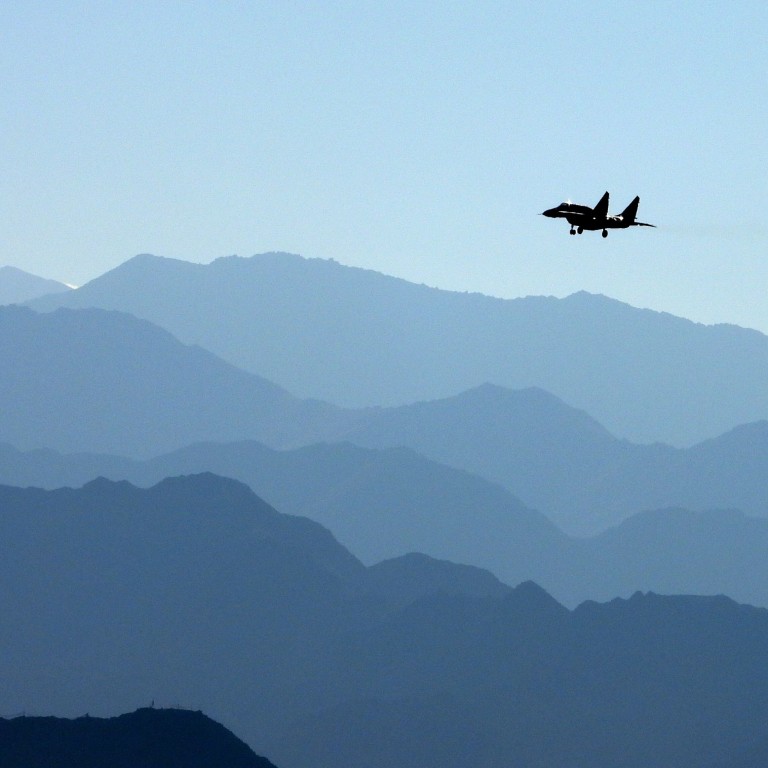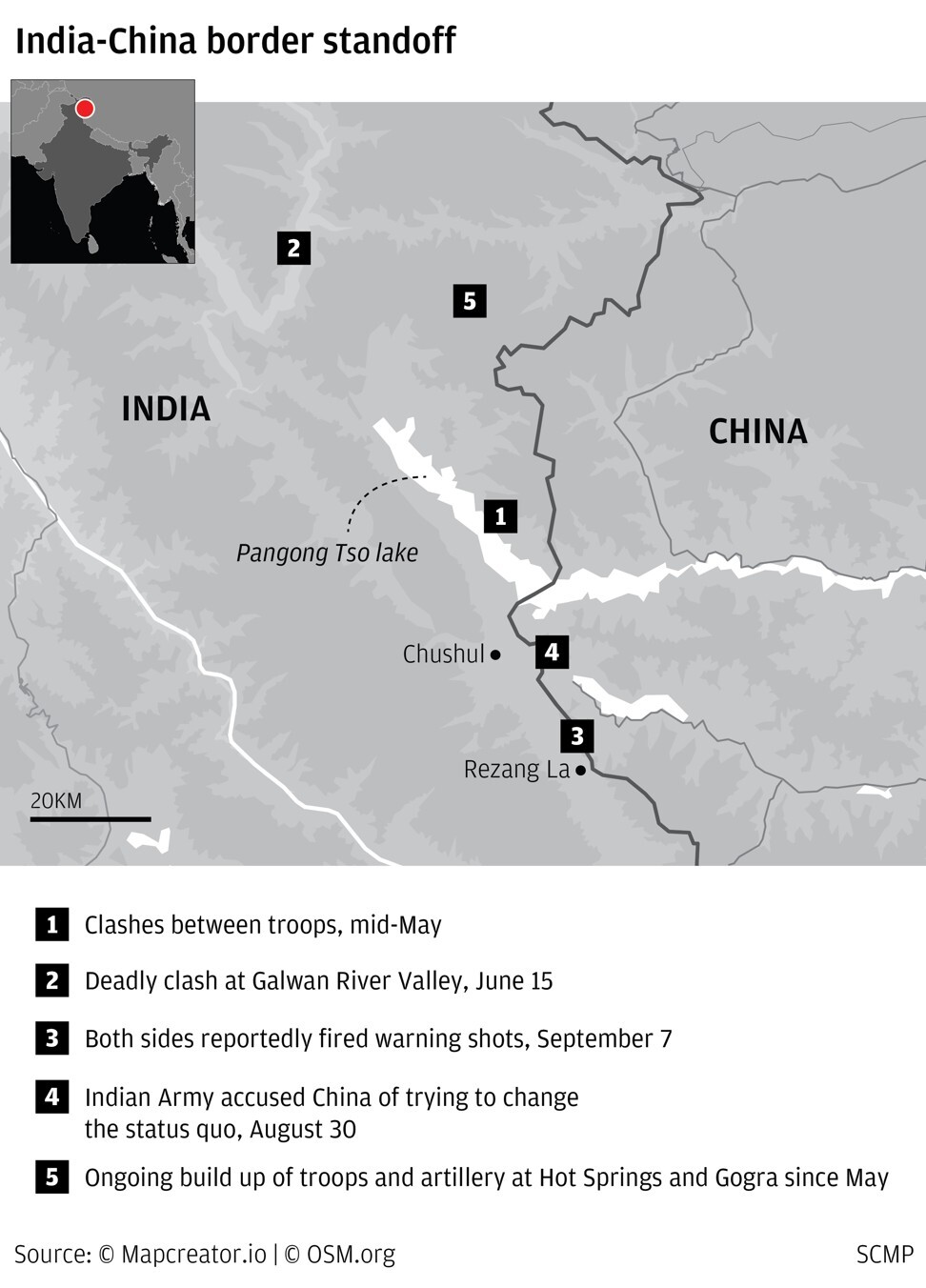
India-China border: stand-off continues in Chushul, where ‘mountains eat up men’
- Troops from both sides are not backing down on the southern banks of Pangong Tso, and veterans say high-altitude warfare is unpredictable
- India’s defence minister Rajnath Singh says the country wants peace but is prepared for all eventualities
“We want peace but we are ready for all eventualities,” Singh said, in his most extensive speech on the face-off that has stretched for 18 weeks with no sign of abating. “We should be confident that our armed forces will handle the situation successfully.”
India-China border: is peace really on the horizon?
Referring to the clash on June 15 – during which soldiers from both sides engaged in brutal hand-to-hand fighting, resulting in the deaths of 20 Indian troops – Singh said the Chinese also suffered “heavy casualties”. Beijing has yet to reveal these numbers.
“The violent conduct of Chinese forces has been in complete violation of all mutually agreed norms,” he said, acknowledging that there continued to be several areas of friction in eastern Ladakh, including the southern bank of Pangong Tso, which is about the size of Singapore.
“Our government too has stepped up the budget for border infrastructure development to about double the previous levels,” he said, without providing a figure. “As a result, more roads and bridges have been completed in the border areas.”
Military officials say the development of roads and airfields on both sides of the border has also helped troops mobilise quickly in large numbers and in close proximity at some points in the Ladakh area.
Last week, a renewed clash – sparked by India’s move to claim strategic peaks in the Chushul sector of eastern Ladakh – led to two incidents of warning shots being fired for the first time in four decades, despite Beijing and New Delhi’s long-standing agreement not to use firearms.
Sources said the decision to send troops to the tops of mountains in Chushul – from Rezang La to Reqin La and the Mukhpari heights, among others – came from a realisation that the deadlock was unlikely to be resolved soon.

A former brigadier in the Indian Army, who holds an official post and is not authorised to speak on the matter, said: “India had to have some military levers to pull, in order to get the Chinese to the talking point. This was what we needed.”
On Monday, Chinese ambassador to India Sun Weidong referred to this operation in a statement, and said this “obviously revealed that there is illegal trespassing [along] the LAC and a status quo change in the border areas”.
But with Indian soldiers manning posts at formidable heights, Chinese efforts to dislodge them could lead to more such incidents of violence as high-altitude warfare can be very unpredictable.
Indian media reports quoting government sources have said that in many places, soldiers are separated by just a few hundred metres and are locked in an “eyeball-to-eyeball” confrontation.
“Mountains eat up men, that is the bottom line for all such warfare,” said another former Indian brigadier who served in the region.
Tibetans help Indian army in China face-off as troops mass at border
MILITARY LEVERS
Indian military veterans say troops occupying heights in the area have created near-impenetrable defences. “It is extremely difficult to be assaulted when one is dominating heights. It is like attacking someone who is on the 30th storey of a tower, while sitting on the ground,” said Sanjay Kulkarni, a retired lieutenant general.
In 1984, he led an army operation to take control of the Siachen Glacier in northern Ladakh, which, at 6,700 metres, is known as the world’s highest battlefield. The current stand-off between India and China in Chushul is taking place at an estimated altitude of 5,000 metres.
Kulkarni ruled out climbing such heights to launch an attack on enemy posts at the top. “Climbing in full sight of enemy fire from the top is deadly,” he said. “Also, at such heights, breathing is difficult anyway and gets even more challenging when one is climbing with loads.”

02:04
New video shows clash between Indian and Chinese troops on border
Apart from the natural advantage they offered, retired brigadier Deepak Sinha – who, as a paratrooper, commanded India’s only rapid deployment force, the 50th Parachute Brigade – said an assault on such altitudes required heavy deployment of manpower.
“If you want to attack, generally, the rule of thumb is that you require nine men for every man perched on the heights,” said Sinha, who has written extensively on high-altitude warfare, adding that weather and atmospheric conditions deal a blow to the aggressor. “Artillery is often not as effective, because the weather – thin air and low visibility – makes it very difficult to aim straight and hit targets from below.”
He said air support was also heavily restricted at that height. “You cannot carry very heavy loads and you can’t carry a lot of fuel. So air power also operates at maybe 50 per cent of its effectiveness.”
India snubs its China-educated doctors even as Covid-19 runs rampant
Kulkarni, the Siachen veteran, believes Indian forces hold an edge over the People’s Liberation Army (PLA) in the current stand-off because of the experience they have in such situations – from Siachen to the 1962 war with China, during which it fought pitched battles to hold on to its positions, as well as the 1947, 1965 and 1999 wars with Pakistan that were fought in the mountainous regions of Kashmir, Leh and Ladakh.
“Against that, the PLA’s last exposure to a conflict was in Vietnam, where it mostly did jungle warfare and on plains,” he said.
On Tuesday, two Indian officials told Reuters that Chinese troops were laying a network of fibre-optic cables, which would provide forward troops with secure lines of communication to bases in the area, though Beijing’s foreign ministry spokesman cast doubt on the report.
“As far as I know, the relevant report is not true,” said Wang Wenbin, adding that China and India would remain in communication through diplomatic and military channels.
CRITICAL SECTORS
The Chushul sector, where the impasse continues, is critical to both sides. For New Delhi, dominating the heights could have a wide-ranging impact, said retired lieutenant general Rakesh Sharma, who commanded India’s Fire and Fury Corps in the region.
“From these points, the Chinese cantonment at Rutog is only 90km away. In addition, there is also a camp at Moldo that comes within reach, and so does the Chinese G219 highway,” he said, referring to the link connecting the autonomous regions of Xinjiang and Tibet.
Retired brigadier Sinha said these heights also gave India the upper hand in the current stand-off on the northern bank of Pangong Tso. Both sides disagree on where the LAC lies, with New Delhi claiming that Chinese troops are 8km into Indian territory. “These heights allow India to maintain a close watch on the ‘Fingers’ of Pangong Tso, so that Chinese activity can be pre-empted,” he said, referring to the mountain spurs above the body of water.
But Sinha pointed out that it was crucial for India to hold on to the sector, for multiple reasons. “If the Chinese occupy Chushul, then they progress to cut off all connectivity to Leh,” he said, referring to the largest city in Ladakh.
From Australia to India and the Philippines, are lockdowns working?
In addition, the Indian advanced landing ground at Chushul, employed in the 1962 war with China, will also be lost. That conflict saw the battle of Rezang La, where 120 Indian soldiers fought for days against thousands of Chinese soldiers before losing control of the crucial pass overlooking the airstrip. However, Beijing announced a unilateral ceasefire before its troops could proceed further into Indian territory.
The heightened sensitivities for both countries at Chushul mean the stand-off is likely to get even trickier to resolve. Many Indian veterans, however, warn that New Delhi might be underestimating the Chinese by believing that an upper hand at Chushul will help it resolve the deadlock.
“The truth is, the troop stand-off continues at all the other points along the LAC. India has no tactical advantages there. So, even if we have Chushul, it does not mean the stand-off is won,” said a retired brigadier.
Sinha, the former paratrooper agreed. “At Depsang Plains as well as Galwan, Chinese forces are still dangerously close to many Indian assets, from the new Darbuk-Shyok-Daulat Beg Oldi highway to the airstrip at Daulat Beg Oldi.”



